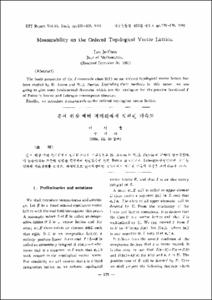기계부품의 수명향상을 위한 표면개질에 관한 연구
- Alternative Title
- The Study on Surface Hardening Treatment for the Lengthening of the Life of Machine Parts
- Abstract
- 본 연구는 질화시간, 온도, 가스입력 및 조성이 공구강(SKD11, SKD61)의 질화층 두께, 경도 및 질화물 상형성에 미치는 영향과 질화처리후 글로잉처리가 질화층 상변화에 미치는 영향을 마이크로펄스 플라즈마 장비를 이용하여 연구하였다.
일반적?막? 질화층은 두께가 엷은 화합물층과 그 아래에 두께가 비교적 큰 확산층으로 구분되어 관찰 되었다. 질화층에 형성된 상은 처리조건에 따라 다소 달라지나 화합물층에는 γ'(Fe₄N). ε(Fe₂-₃N), 및 Cr1.75V0.25N₂ 등과 같은 질화물만이 검출되었고 확산층에는 ε질화물(Fe₂-₃N)과 (Cr, Fe)7C₃, Fe₃C와 같은 탄화물이 XRD 분석에 의하여 검출 되었다.
질화처리에서 가스조성 중 질소의 양이 증가할수록 화합물층의 두께는 직선적으로 증가되며, 질화층 두께는 가스압력 200Pa일 때 최대가 되었고, 질화온도는 표면경도가 높고 모재의 경도감소를 피할 수 있는 490℃가 최적조건 이었다. 질화층은 포물선형으로 성장되며, 에서 온도 및 재질에 따라 결정되는 상수 k는 490℃, 200Pa에서 SKD11강은 0.04472×10³㎛·hr-½, SKD61강은 0.05367×10³㎛·hr-½이었다.
플라즈마 질화처리한 공구강을 글로잉 처리하면 표면경도는 다소 감소 되나 확산층의 깊이는 증가하며, 이때 화합물층은 (Cr, Fe)7C₃ 및 Fe₃C의 탄화물로 변화되였고 확산층은 상변화가 없었다.
The effect of gas composition, pressure, temperature and time on the case thickness, hardness and nitride formation in the surface of tool steels (SKD11 an SKD61) have been studied by micro-pulse plasma technique. Together with the effects of glowing treatment on the phase transformation in the nitrided case of tool steels have also been studied.
Typically, external compound sayer and internal diffusion sayer which is much thicker than compound layer was observed in the nitride case of tool steels. The relative amounts and kind of phases formed in the nitrided case changed with the change of nitriding conditions. Generally, only nitride phases such as γ'(Fe₄N). ε(Fe₂-₃N), or Cr1.75V0.25N₂ phases were detected in compound layer, while nitride and carbide phases such as ε-nitride(Fe₂-₃N), (Cr, Fe)7C₃ or Fe₃C have been detected in the duffusion layer by XRD analysis.
The thickness of compound layer increased with the increase of nitrogen content in the gas composition. Maximum case thickness was obtained at gas pressure of 200Pa. The optimum nitriding temperature was 490℃ at which temperature high have nitrided case was obtained without the decrease in the hardness of tool steel substrate. The nitrided case was thickened parabolically with nitriding time(t) and thus, the case depth(d) fits well with the typical parabolic equation ; d=k√t. The material constant k for SKD11 and SKD61 nitrided at 490℃(200Pa) were 0.04472×10³㎛·hr-½ and 0.05367×10³㎛·hr-½ respectively.
Plasma glowing treatment of nitrided tool steel thickened the diffusion layer of nitrided case and transformed nitride in the compound layer to carbide as ((Cr, Fe)7C₃.
The effect of gas composition, pressure, temperature and time on the case thickness, hardness and nitride formation in the surface of tool steels (SKD11 an SKD61) have been studied by micro-pulse plasma technique. Together with the effects of glowing treatment on the phase transformation in the nitrided case of tool steels have also been studied.
Typically, external compound sayer and internal diffusion sayer which is much thicker than compound layer was observed in the nitride case of tool steels. The relative amounts and kind of phases formed in the nitrided case changed with the change of nitriding conditions. Generally, only nitride phases such as γ'(Fe₄N). ε(Fe₂-₃N), or Cr1.75V0.25N₂ phases were detected in compound layer, while nitride and carbide phases such as ε-nitride(Fe₂-₃N), (Cr, Fe)7C₃ or Fe₃C have been detected in the duffusion layer by XRD analysis.
The thickness of compound layer increased with the increase of nitrogen content in the gas composition. Maximum case thickness was obtained at gas pressure of 200Pa. The optimum nitriding temperature was 490℃ at which temperature high have nitrided case was obtained without the decrease in the hardness of tool steel substrate. The nitrided case was thickened parabolically with nitriding time(t) and thus, the case depth(d) fits well with the typical parabolic equation ; d=k√t. The material constant k for SKD11 and SKD61 nitrided at 490℃(200Pa) were 0.04472×10³㎛·hr-½ and 0.05367×10³㎛·hr-½ respectively.
Plasma glowing treatment of nitrided tool steel thickened the diffusion layer of nitrided case and transformed nitride in the compound layer to carbide as ((Cr, Fe)7C₃.
- Issued Date
- 1999
- Type
- Research Laboratory
- Alternative Author(s)
- Yoo, Young-Zoo
- Publisher
- 연구보고서
- Language
- kor
- Rights
- 울산대학교 저작물은 저작권에 의해 보호받습니다.
- Citation Volume
- 1999
- Citation Start Page
- 247
- Citation End Page
- 291
- Appears in Collections:
- Research Laboratory > 연구보고서
- 파일 목록
-
-
Download
 000002025432.pdf
기타 데이터 / 174.72 kB / Adobe PDF
000002025432.pdf
기타 데이터 / 174.72 kB / Adobe PDF
-
Items in Repository are protected by copyright, with all rights reserved, unless otherwise indicated.